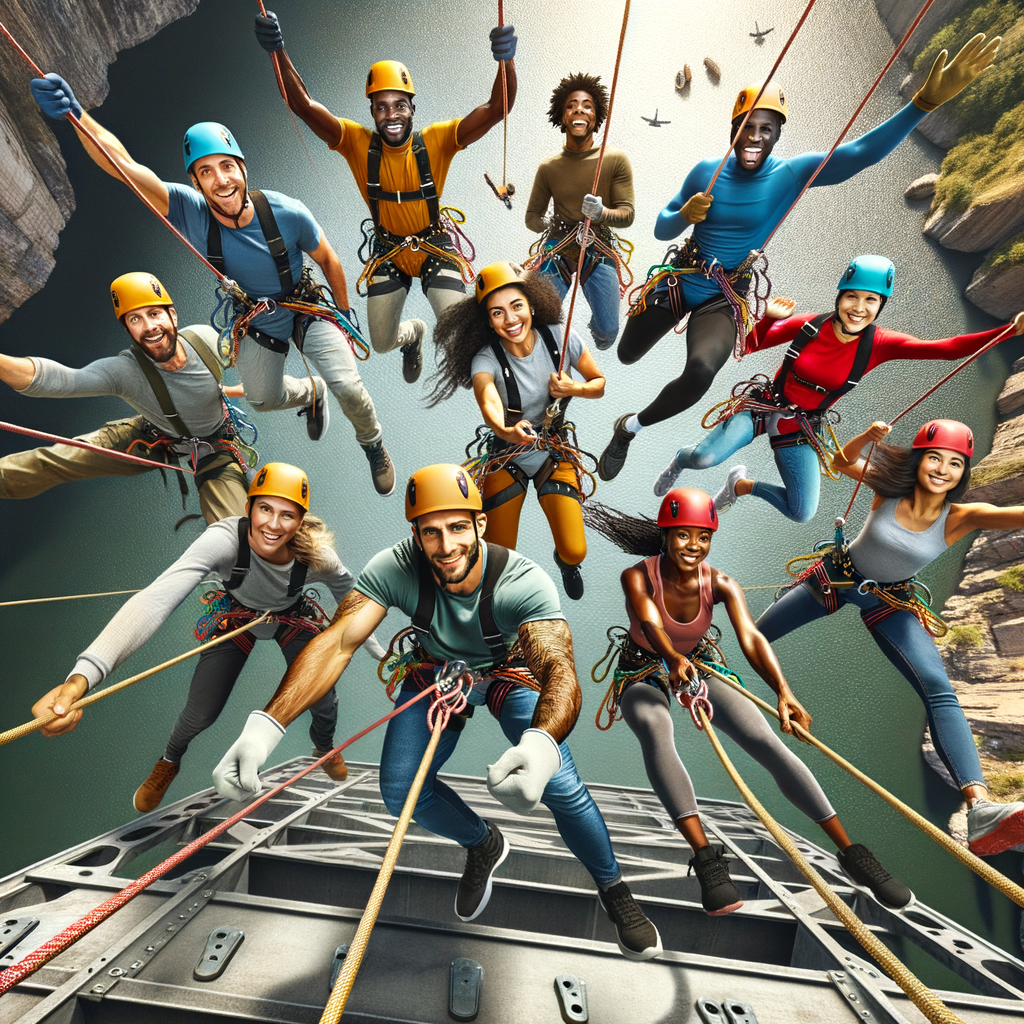
Introduction to Rappelling Adventure
Welcome to the thrilling world of rappelling! This exciting outdoor activity is not only a test of strength and endurance, but also a fun way to enjoy the great outdoors. In this post, we will explore what rappelling is, why it’s becoming a popular adventure sport, and the benefits of engaging in outdoor activities like rappelling.
-
Definition and Overview of Rappelling
Rappelling, also known as abseiling, is a technique used in rock climbing where you descend down a cliff or wall by sliding down a rope. It’s a controlled descent, meaning you can control your speed and direction. This is done using a harness and a special device called a descender. Rappelling is used in a variety of situations, including mountaineering, caving, canyoning, and in rescue operations.
-
Popularity of Rappelling as an Adventure Sport
Over the years, rappelling has gained popularity as an adventure sport. According to a survey by the Outdoor Foundation, rock climbing (which includes rappelling) is among the top 10 outdoor activities for young people aged 6 to 24. The thrill of descending down a rock face, the challenge it presents, and the unique perspective it offers of the natural world are just a few reasons why more and more people are drawn to this sport.
-
Benefits of Engaging in Outdoor Activities like Rappelling
Participating in outdoor activities like rappelling has numerous benefits. It’s a great way to stay physically fit as it engages various muscle groups. It also promotes mental well-being by helping reduce stress and anxiety. Moreover, it encourages teamwork and develops problem-solving skills as you navigate your way down. Lastly, it allows you to connect with nature, which has been shown to boost happiness and well-being.
| Benefits of Rappelling | Details |
|---|---|
| Physical Fitness | Engages various muscle groups, improving strength and endurance. |
| Mental Well-being | Helps reduce stress and anxiety, promoting mental health. |
| Teamwork and Problem-solving | Encourages cooperation and develops problem-solving skills. |
| Connection with Nature | Boosts happiness and well-being by allowing you to interact with the natural world. |
Unconventional Rappelling Locations
Let’s explore the world of extreme rappelling, where adventurers push the limits and take the sport to new heights, literally and figuratively.
Extreme Rappelling: Pushing the Limits
- Case Study: Rappelling Down Skyscrapers
Urban rappelling, also known as “rope access,” involves descending from towering skyscrapers. It’s not just for thrill-seekers, but also for window cleaners and maintenance crews. The Petronas Twin Towers in Kuala Lumpur, standing at a staggering height of 452 meters, is a popular spot for this activity.
- Case Study: Rappelling in Caves and Underground Locations
Caving or spelunking takes rappelling underground. The Majlis al Jinn Cave in Oman, one of the largest underground caves in the world, offers a 120-meter vertical drop for rappelling enthusiasts.
- Case Study: Rappelling from Hot Air Balloons
For those who crave a more adrenaline-pumping experience, rappelling from hot air balloons is an option. This activity combines the thrill of a balloon ride with the excitement of a rapid descent.
- Spot 1: Description and Unique Features
Angel Falls in Venezuela, the world’s highest waterfall, offers a 979-meter rappelling experience. The unique feature here is the sheer height and the breathtaking view of the surrounding rainforest.
- Spot 2: Description and Unique Features
The Verdon Gorge in France, known for its turquoise-green color, offers a 700-meter descent. The unique feature here is the stunning view of the river canyon.
- Spot 3: Description and Unique Features
The El Capitan in Yosemite National Park, USA, is a popular spot for rappelling. The unique feature here is the 900-meter vertical rock formation, a challenge even for experienced rappellers.
- Technique 1: Description and When to Use
The Australian Rappel involves facing downward during the descent. It’s best used when you need a clear view of your landing spot.
- Technique 2: Description and When to Use
The Standard Rappel technique involves facing the cliff and using your feet to push off. It’s the most common technique used in rappelling.
- Technique 3: Description and When to Use
The Tandem Rappel technique involves two people rappelling together. It’s used when one of the rappellers is less experienced.
- Gear 1: Description and Importance
A rappelling rope is the most important piece of equipment. It must be strong, durable, and long enough for the descent.
- Gear 2: Description and Importance
A rappelling harness is worn around the waist and thighs. It’s crucial for safety as it connects the rappeller to the rope.
- Gear 3: Description and Importance
A rappelling device controls the rope’s speed during the descent. It’s important for controlling the pace of the rappel and preventing free falls.
- Understanding Risks in Rappelling
Rappelling involves risks such as equipment failure, rockfall, and sudden weather changes. It’s important to be aware of these risks and prepare accordingly.
- Importance of Proper Training and Preparation
Proper training and preparation are crucial in rappelling. They ensure safety and increase the chances of a successful descent.
- Measure 1: Description and Importance
Always check your equipment before a rappel. This simple measure can prevent accidents caused by equipment failure.
- Measure 2: Description and Importance
Always have a backup plan. In case of unexpected situations like bad weather or injury, a backup plan can save lives.
- Measure 3: Description and Importance
Never rappel alone. Having a partner can provide assistance in case of emergencies.
- Experience 1: Description and Key Takeaways
Rappelling down the Petronas Twin Towers was a thrilling experience. The key takeaway was the importance of overcoming fear and trusting your equipment.
- Experience 2: Description and Key Takeaways
Rappelling in the Majlis al Jinn Cave was a unique experience. The key takeaway was the importance of adaptability in different environments.
- Experience 3: Description and Key Takeaways
Rappelling from a hot air balloon was an adrenaline-pumping experience. The key takeaway was the importance of embracing new challenges.













